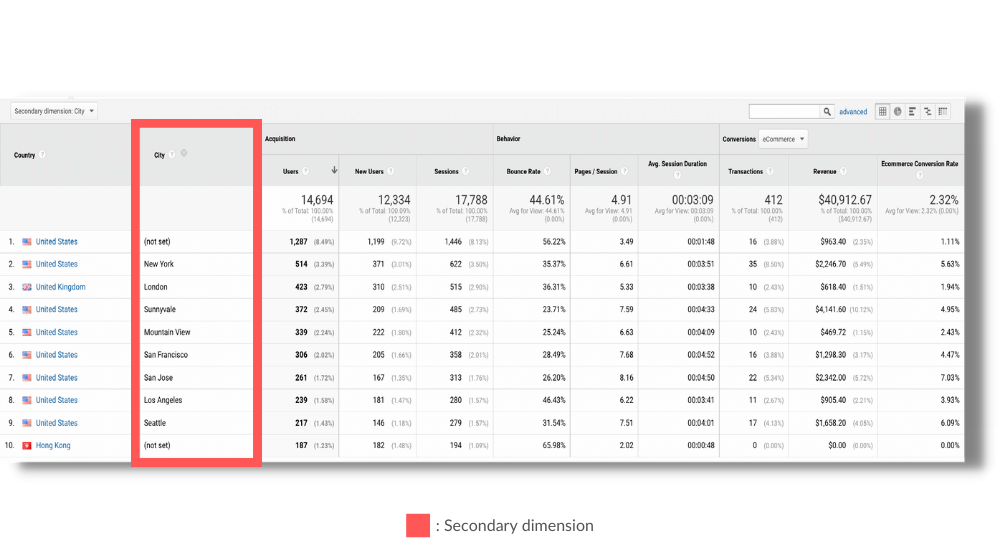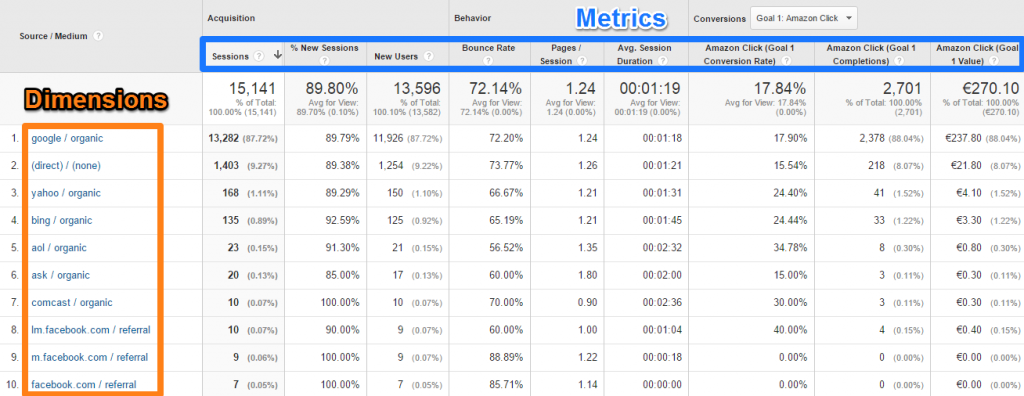Discussed: The Role and Interpretation of a 'Secondary Dimension' in Google Analytics
Wiki Article
Browsing the Midst of Additional Measurement in Google Analytics: A Comprehensive Expedition on Its Functionality
In the world of digital analytics, the details of information analysis often hold the secret to opening beneficial understandings. Within the large toolkit of Google Analytics exists an attribute that functions as a concealed gem for those that look for a much deeper understanding of individual behavior and internet site performance. Secondary dimensions, though apparently simple initially glance, nurture a wide range of untapped possible waiting to be used. As we embark on this journey to explore the nuanced performance of additional measurements, we will certainly reveal exactly how this feature can brighten patterns, introduce relationships, and eventually pave the means for informed decision-making in the electronic landscape.Comprehending Secondary Measurements in Google Analytics

Recognizing how second measurements work is essential for leveraging the complete power of Google Analytics. By incorporating main metrics with secondary dimensions, you can gain beneficial insights that drive informed decision-making and optimization techniques.
Leveraging Secondary Measurements for Information Analysis
Building upon the foundational understanding of just how second dimensions boost information evaluation in Google Analytics, the application of these additional layers of info comes to be critical in drawing out important insights for informed decision-making and optimization methods. By leveraging second measurements, experts can delve deeper right into the efficiency metrics by adding even more context to the main measurements, thus revealing surprise patterns and relationships that may not appear at very first glance. This deeper level of analysis makes it possible for services to better comprehend user actions, identify trends, and determine locations for renovation.
Additionally, second measurements provide an even more detailed view of the data, permitting division based upon various criteria such as demographics, tools, traffic sources, and much more. This segmentation facilitates a more granular evaluation, allowing services to customize their projects and methods to certain audience sections for improved targeting and customization. Essentially, the calculated use second dimensions encourages organizations to make data-driven choices that drive growth and success in the digital landscape.
Advanced Methods for Second Measurement Implementation
Discovering detailed methods to harness the full possibility of additional dimensions in Google Analytics raises the deepness and sophistication of data analysis for critical decision-making. One sophisticated method for implementing secondary measurements is making use of custom dimensions. By specifying custom measurements, users can segment information additionally to gain even more particular insights into user behavior, such as tracking communications with certain components on a page or keeping an eye on the performance of a specific advertising project. One more innovative strategy is the application of regex (routine expressions) within secondary dimensions. Regex allows for even more versatile and powerful pattern matching, allowing users to develop intricate filters for data analysis. Additionally, integrating second measurements with advanced sections can provide a lot more granular understandings by using multiple layers of division to the data. This method permits a much deeper understanding of user moved here habits based upon numerous standards concurrently. Carrying out these advanced techniques for secondary measurements in Google Analytics encourages users to perform extra advanced analysis and make data-driven choices with accuracy.Interpreting Insights Through Additional Measurements

When translating insights via secondary dimensions, it is vital to think about the context of the information and how various measurements communicate with each other. Understanding which details website traffic sources lead to greater conversion rates or recognizing which tools users prefer check these guys out for making purchases can supply workable understandings for maximizing marketing projects and improving total web site efficiency. By carefully examining the information with additional measurements in mind, businesses can make educated choices that drive purposeful outcomes and enhance their digital visibility.
Optimizing Efficiency With Additional Measurements

One key way to optimize efficiency with secondary dimensions is by segmenting information extra granularly. This allows you to separate specific elements that might be affecting your metrics and obtain a far better understanding of what drives success or failure in your digital initiatives. For example, by combining additional measurements such as 'device group' and 'touchdown web page,' you can pinpoint which tool kinds are most effective for specific landing pages, enabling you to customize your methods appropriately.
Moreover, making use of additional dimensions can help you determine trends, patterns, and connections that may not be apparent when analyzing data with primary measurements alone. This deeper degree of evaluation can bring about more enlightened decision-making and inevitably enhance the general performance of your browse this site website or digital marketing campaigns.
Final Thought
To conclude, second dimensions in Google Analytics play a crucial function in boosting data analysis and supplying deeper insights right into site performance. By utilizing sophisticated methods and interpreting the information efficiently, companies can optimize their approaches and enhance total efficiency. Comprehending the functionality of second measurements is important for making notified choices and driving success in the digital landscape.By leveraging additional dimensions, experts can delve much deeper right into the efficiency metrics by including more context to the key measurements, hence revealing surprise patterns and connections that could not be evident at first look. One innovative strategy for applying additional dimensions is the usage of personalized measurements.Having grasped advanced techniques like custom measurements and regex for secondary measurement execution in Google Analytics, the following crucial step is translating the useful understandings acquired with these innovative information division techniques. Analyzing understandings through additional measurements entails examining the partnerships between the additional and key measurements picked, discovering patterns, patterns, and connections that may not be instantly evident when looking at the data in its totality.When analyzing insights with second dimensions, it is crucial to think about the context of the information and how various measurements communicate with each various other.
Report this wiki page